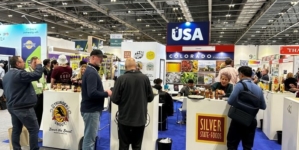-
POCKET BOX TARGETS ROAD TRANSPORT SECTOR WITH ASSET MANAGEMENT ENHANCEMENT - 3 hours ago
-
PINPOINTERS ENHANCES FLEET AND VIDEO TELEMATICS OFFERING WITH LINK-UP WITH QUECLINK WIRELESS SOLUTIONS - 1 day ago
-
BCMPA HELPS TO OPEN DOORS FOR US TRADE PARTNERSHIPS - 1 day ago
-
ARROWXL SECURES FIFTH CONSECUTIVE GOLD ROSPA AWARD - April 19, 2024
-
Delivery management platform, Scurri topped over €12 billion in Gross Merchandise Value (GMV) in the total value of shipments processed in 2023 - April 17, 2024
-
Britvic reaffirms partnership with LPR - April 17, 2024
-
Kammac Supports Nimble’s Expansion into 500 Tesco Stores - April 5, 2024
-
Axiom Sustainability Software launches groundbreaking Social Value Calculator - April 4, 2024
-
Change to minimum wage and its impact on logistics - April 3, 2024
-
PARKSAFE GROUP TEAMS UP WITH QUECLINK WIRELESS SOLUTIONS IN FLEET TECHNOLOGY PARTNERSHIP - March 27, 2024
New Offerings Promise to Improve Sustainable Leather Supply Chain.
As fibers move toward more sustainable versions of themselves, leather has trailed behind. But new solutions look set to make the leather supply chain more sustainable.
Dutch chemical solutions company Stahl will launch its Sustainable Leather Campaign at the All China Leather Exhibition (ACLE) in Shanghai this week, hoping to get quick attention and support for the campaign.
To improve leather’s sustainability, it’s all about what the tanners are using.
“It starts at the beginning of the chain in the beamhouse,” the company said in a statement. “Preparing hides for tanning in a more sustainable way, Proviera – Probiotics for Leather reduces the wastewater that comes from beamhouse systems and replaces traditional leather chemicals with 100 percent natural products.”
From there, Stahl said its leather tanning system, EasyWhite Tan, creates chrome-free leather using 40 percent less water during the tanning process and cuts the salt in the wastewater by at least 80 percent. That process is followed up with a finish portfolio called Stahl Neo, which the company said is free of all substances on the ZDHC Manufacturing Restricted Substances List (MRSL).
In that same vein, special chemicals company Lanxess, as part of its Sustainable Leather Management initiative, will launch this week new retanning agents with reduced residual monomer content, which can be hazardous for workers.
“One of the greatest challenges facing the leather industry over the next few years is to become less dependent on fossil raw materials by gradually replacing petroleum based chemicals,” the company said in a statement.
The company will launch a new retanning agent from its Levotan X-Biomer range that’s based on renewable raw materials. For this range, instead of taking leather by-products to large-scale industrial facilities far from the tanneries to be processed into retanning agents, the company processes the by-products into retanning agents in the same tanneries where they are generated.
In partnership with research institute INVITE, Lanxess also developed a pilot plan for manufacturing retanning agents from by-products of leather production that contain collagen and organic biomass.
“These cutting-edge, sustainable and high-performance products augment our range and reinforce our technical application offering worldwide,” said Dr. Thomas Brackemeyer, head of the Organic Leather Chemicals business line at LEA, the leather business unit of Lanxess. “We see it as our duty to offer tanneries innovative products that they can use to produce leather of outstanding quality to meet the needs of the future including with respect to profitability, environmental protection and fashion trends,” he states. “For example, one of our services involves providing tanneries with leather samples twice a year to give them a foretaste of future leather trends in terms of colors, structures, feel and overall appearance. Based on these recommendations, tanners can adapt to future trends and implement them in good time.”
First published at Sourcing Journal Online.























